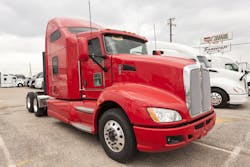Gaskins: Is it time to revisit the purchase and leaseback option?
The economy, business conditions, and interest rates have all contributed to businesses looking for ways to retain cash.
Of course, there are many ways for a business owner to infuse cash back into the business. The sale and leaseback of capital equipment like medium- and heavy-duty trucks may be an option they should consider.
Here's how it works. The owner of the asset, in this case a Class 8 truck, sells the asset and then leases it back from the buyer. In this type of transaction, the buyer of the asset is now the lessor, while the seller of the asset becomes the lessee. In a purchase and leaseback, the seller (lessee) treats the income from the sale as normal income/revenue. The lessor can take depreciation.
See also: Clark: In a complex trucking world, leasing makes sense
The benefit of the purchase and leaseback arrangement is that the seller continues to use the asset while freeing up cash for other business needs.
An added benefit of purchase and leaseback is that it can help fleets manage the lifecycle of their assets. In light of the continual supply chain issues, allocations, the explosion of new powertrain technologies, and regulations limiting the use of diesel-powered trucks, this is of utmost importance.
There are many fleets with assets of various ages, and many have been forced to hold onto assets past their normal trade-in period. Purchase and leaseback allows fleet managers to optimize their fleets by selling the oldest assets while putting the mid-range assets on short-term leases and the newest assets on long-term leases.
See also: Gaskins: Five questions to ask your trucking finance source
Purchase and leaseback provides the fleet with immediate cash while rationalizing asset replacement cycles across the fleet.
When a purchase and leaseback agreement is executed, the residual risk is transferred from the seller to the lessor, which is a plus in today’s volatile used truck market. The fleet also may be able to finance the assets at a lower interest rate.
In today’s uncertain environment, you may want to investigate purchase and leaseback as a way to bring some needed cash into your business while also improving asset replacement cycles.
Patrick Gaskins, SVP of Corcentric Fleet Solutions, oversees both sales and operations for the company's fleet offerings. Gaskins joined the company in 2010, bringing more than 30 years of experience as a financial services professional in the transportation industry. He leads a team that works with a supply base of more than 160 manufacturers to help the country's largest fleets manage all aspects of their fleet operations and fleet-related spending.
About the Author

Patrick Gaskins
Senior vice president, Fleet Solutions
Pat Gaskins is the senior vice president of Corcentric Fleet Solutions, where he leads both the sales and operations teams for the company’s fleet offerings. He has over 30 years of experience as a financial services professional in the transportation industry and manages partnerships with over 160 manufacturers, helping over 2,000 of the country’s largest fleets manage all aspects of their fleet operations and fleet-related spend.
